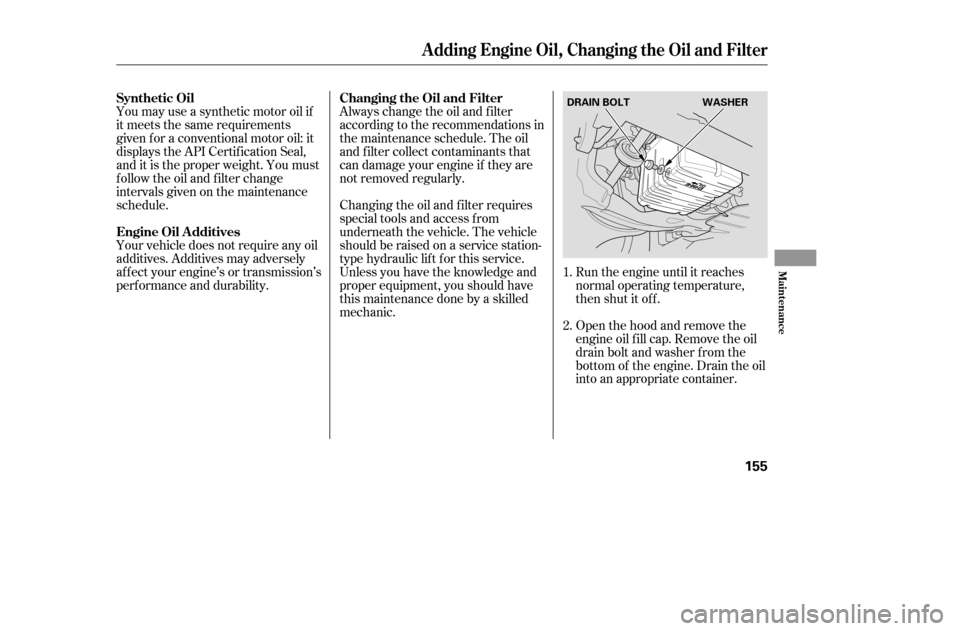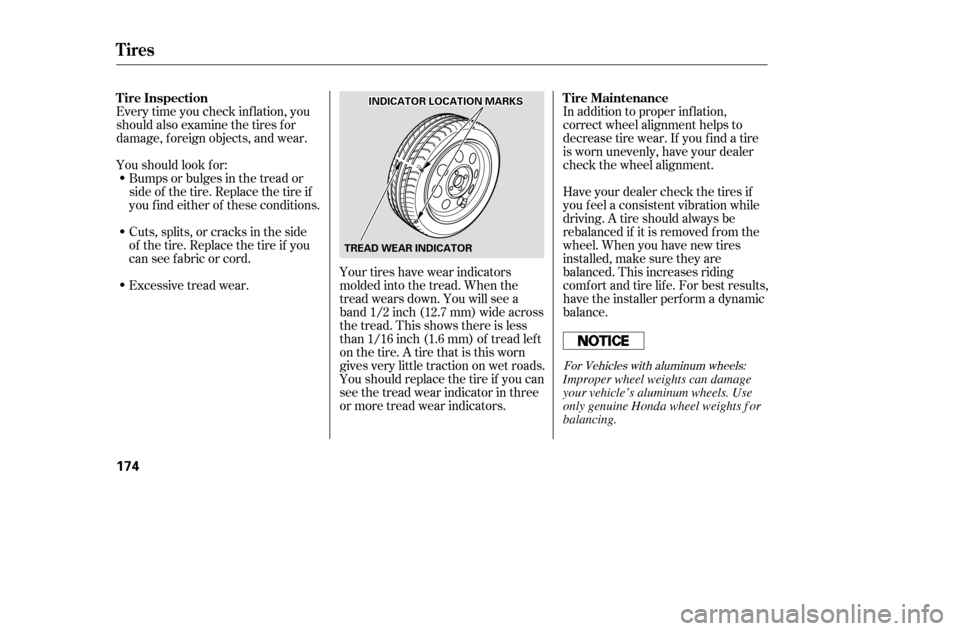Page 146 of 223

Run the engine until it reaches
normal operating temperature,
then shut it off.
Open the hood and remove the
engine oil f ill cap. Remove the oil
drain bolt and washer f rom the
bottom of the engine. Drain the oil
into an appropriate container.
Always change the oil and f ilter
according to the recommendations in
the maintenance schedule. The oil
and f ilter collect contaminants that
can damage your engine if they are
not removed regularly.
Changing the oil and f ilter requires
special tools and access f rom
underneath the vehicle. The vehicle
should be raised on a service station-
type hydraulic lif t f or this service.
Unless you have the knowledge and
proper equipment, you should have
this maintenance done by a skilled
mechanic.
You may use a synthetic motor oil if
it meets the same requirements
given f or a conventional motor oil: it
displays the API Certif ication Seal,
and it is the proper weight. You must
f ollow the oil and f ilter change
intervals given on the maintenance
schedule.
Your vehicle does not require any oil
additives. Additives may adversely
af f ect your engine’s or transmission’s
perf ormance and durability.
1. 2.
Changing the Oil and Filter
Synthetic Oil
Engine Oil A dditives
A dding Engine Oil, Changing the Oil and Filter
Maint enance
155
DRAIN BOLT WASHER
�����—�����—�����y�
���������
���y���
�(�����������y���
�����y
Page 165 of 223

Every time you check inf lation, you
should also examine the tires f or
damage, f oreign objects, and wear.
Youshouldlookfor:Bumps or bulges in the tread or
side of the tire. Replace the tire if
youfindeitherof theseconditions.
Cuts, splits, or cracks in the side
of the tire. Replace the tire if you
can see f abric or cord.
Excessive tread wear. Your tires have wear indicators
molded into the tread. When the
tread wears down. You will see a
band 1/2 inch (12.7 mm) wide across
the tread. This shows there is less
than 1/16 inch (1.6 mm) of tread lef t
on the tire. A tire that is this worn
gives very little traction on wet roads.
Youshouldreplacethetireif youcan
see the tread wear indicator in three
or more tread wear indicators. In addition to proper inf lation,
correct wheel alignment helps to
decrease tire wear. If you f ind a tire
is worn unevenly, have your dealer
check the wheel alignment.
Have your dealer check the tires if
you f eel a consistent vibration while
driving. A tire should always be
rebalanced if it is removed f rom the
wheel. When you have new tires
installed, make sure they are
balanced. This increases riding
comf ort and tire lif e. For best results,
have the installer perform a dynamic
balance.
For Vehicles with aluminum wheels:
Tire Inspection
Tire Maintenance
Tires
174
TREAD WEAR INDICATOR
IINNDDIICCAATTOORRLLOOCCAATTIIOONNMMAARRKKSS
Improper wheel weights can damage
your vehicle’s aluminum wheels. Use
only genuine Honda wheel weights f or
balancing.
�����—�����—�����y�
�������������y���
�(�����������y���
�����y
Page 193 of 223

With the f ront wheels on the ground,
it is best to tow the car no farther
than 50 miles (80 km), and keep the
speedbelow35mph(55km/h).
If your vehicle is equipped with a
f ront spoiler, remove it bef ore
towing so it is not damaged.If you decide to tow your vehicle
with all f our wheels on the ground,
make sure you use a properly-
designed and attached tow bar.
Prepare the vehicle for towing as
described above, and leave the
ignition switch in Accessory (I) so
the steering wheel does not lock.
Make sure the radio and any items
plugged into the accessory power
socket are turned of f so they do not
rundownthebattery.
Emergency T owing
T aking Care of t he Unexpect ed
203
The steering system can be damaged if
the steering wheel is locked. Leave the
ignition switch in Accessory (I), and
make sure the steering wheel turns
f reely bef ore you begin towing.Trying to lif t or tow your vehicle by the
bumpers will cause serious damage.
The bumpers are not designed to
support the vehicle’s weight.
�����—�����—�����y�
�������������y���
�(�����������y���������y
Page 197 of 223

�Î�Î�Î �Î �Î�Î�Î�Î
�Î �Î
�Î �Î
�Î �Î �Î�Î
�´ �µ
Specif ications
208
Dimensions
Weights
Engine Capacities
174.6 in (4,435 mm)
67.3 in (1,710 mm)
56.9 in (1,445 mm)
103.1 in (2,620 mm)
57.9 in (1,470 mm)
57.9 in (1,470 mm)
2.95 x 3.72 in (75.0 x 94.4 mm) 13.2 US gal (50
)
1.03 US gal (3.9
)
102 cu-in (1,668 cm
)
9.5 9.9 1.06 US gal (4.0
)
1.35 US gal (5.1
)
1.32 US gal (5.0)
3.4 US qt (3.2
)
3.7 US qt (3.5)
3.2 US qt (3.0)
3.5 US qt (3.3)
4.4 US qt (4.2)
1.6 US qt (1.5)
1.7 US qt (1.6)
2.9 US qt (2.7)
6.2 US qt (5.9)
2.6 US qt (2.5
)
4.8 US qt (4.5)
0.11 US gal (0.4
)
Including the coolant in the reserve tank and that remaining in the
engine.
Reserve tank capacity:
Excluding the oil remaining in the engine.
Length
Width
Height
Wheelbase
Track
Gross vehicle weight ratingType
BorexStroke
Displacement
Compression ratio
Spark plugs
Fuel tank
Engine
coolant
Engine oil Automatic
transmission
fluid
Water cooled 4-stroke
SOHC , SOHC VTEC
4-cylinder gasoline engine
See the certification label attached
to the driver’s doorjamb.
PZFR6F-11PKJ20CR-M11
NGK:
DENSO:
0.04 in (1.1 mm)
FrontRear
Approx.
1:
2 : EX, Canadian Si EX, Canadian Si
1: 2: 3:4:
Spark Plug Gap: Change
ManualAutomatic
Total
ManualAutomatic
Change
Without filter
Total
ChangeTotal
ChangeTotal
U.S. Vehicles
Canada Vehicles
DX, LX, Canadian SE, LX-G DX, LX, Canadian SE, LX-G
Manual trans-
mission fluidIncluding filter
Windshield
washer reservoir
12
12 3434
1 2
0
0.1 mm
�����—�����—�����y�
�������������y���
�(�����������y�����
�
�y